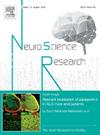A decade progress in the phenotyping of AppNL-G-F knock-in mouse model of Alzheimer’s disease
IF 2.3
4区 医学
Q3 NEUROSCIENCES
引用次数: 0
Abstract
Numerous mouse models of Alzheimer’s disease (AD) have developed since the discovery of mutations causing familial AD. These models successfully recapitulate the progressive amyloid pathology over time, thus serving as indispensable tools for improving our understanding of the pathogenesis. However, there is a growing concern about artificial phenotypes in these transgenic mouse models, resulting from overexpression of mutant amyloid precursor protein (APP) under artificial promoters. To address this issue, App knock-in (KI) mice were developed to produce mutated human β-amyloid (Aβ) from the endogenous App locus. Since the first characterisation in 2014, gathering evidence has made significant progress in the phenotype analysis of this mouse model. Here, we provide an update on novel phenotypes observed in AppNL-G-F KI mice. In particular, we will highlight how the progression of amyloid pathology is related to neuronal pathology, behavioural phenotype, and microglial response.
apnl - g - f敲入小鼠阿尔茨海默病模型的表型研究进展
自从发现引起家族性阿尔茨海默病的突变以来,已经开发了许多阿尔茨海默病(AD)的小鼠模型。这些模型成功地概括了淀粉样蛋白随时间的进展病理,从而成为提高我们对发病机制理解的不可或缺的工具。然而,在这些转基因小鼠模型中,由于在人工启动子下突变淀粉样前体蛋白(APP)过表达而导致的人工表型越来越受到关注。为了解决这一问题,研究人员开发了App敲入(KI)小鼠,从内源性App位点产生突变的人β-淀粉样蛋白(Aβ)。自2014年首次表征以来,收集证据已经在该小鼠模型的表型分析方面取得了重大进展。在这里,我们提供了在AppNL-G-F KI小鼠中观察到的新表型的最新进展。特别是,我们将强调淀粉样蛋白病理的进展如何与神经元病理、行为表型和小胶质细胞反应相关。
本文章由计算机程序翻译,如有差异,请以英文原文为准。
求助全文
约1分钟内获得全文
求助全文
来源期刊

Neuroscience Research
医学-神经科学
CiteScore
5.60
自引率
3.40%
发文量
136
审稿时长
28 days
期刊介绍:
The international journal publishing original full-length research articles, short communications, technical notes, and reviews on all aspects of neuroscience
Neuroscience Research is an international journal for high quality articles in all branches of neuroscience, from the molecular to the behavioral levels. The journal is published in collaboration with the Japan Neuroscience Society and is open to all contributors in the world.
 求助内容:
求助内容: 应助结果提醒方式:
应助结果提醒方式:


